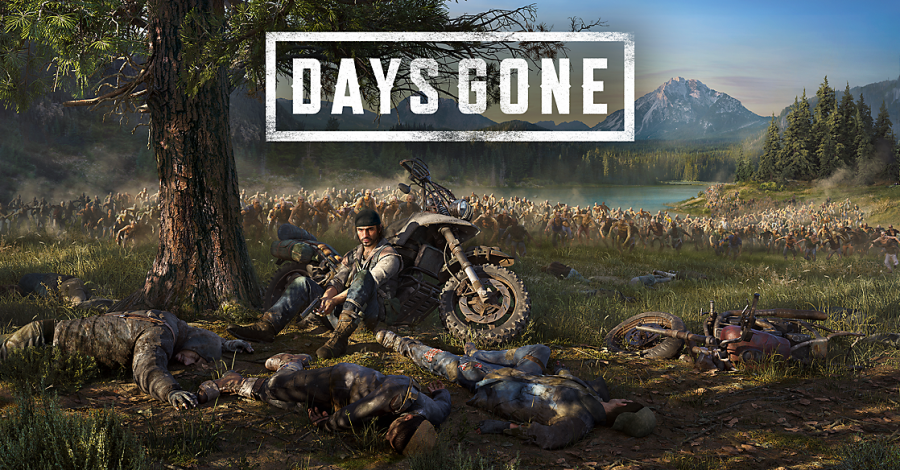Days Gone review
Freaks and Deac
September 24, 2019
‘Days Gone,’ a PlayStation exclusive developed by SIE Bend Studio, is a perfectly adequate gaming experience that could have been so much more. It creates a constant feeling of one step forward and one step back. While there are numerous gameplay and story developments that are enjoyable, there are just as many that frustrate.
The world of ‘Days Gone’ has been overrun by zombie-like creatures. Mass swarms of humanity have become albino monstrosities dubbed Freakers. These Freakers fulfill all the usual tropes associated with zombies. Players take control of Deacon St. John, a former motorcycle gang member, played by Sam Witwer (known best for his roles as StarKiller in ‘The Force Unleashed’ and as the voice of Darth Maul.) When the Freakers first emerged, St. John is separated from his wife, whom he believes to be dead. He spends the next two years trying to realize his death wish by fighting as many Freakers as possible. It is only when he discovers hints that his wife may be alive that he starts to hope that this world just might be worth fighting for.
There are four main gameplay mechanics: driving, gunplay, melee and crafting. St. John’s bike is almost a character in and of itself, but it generally runs well and is easy to control. As you advance the story and build up trust with survivor camps, you will be able to modify, customize and upgrade your bike. Early on St. John suffers the same indignity that befalls many protagonists who are fully equipped at the start of the game: the loss of said equipment. His bike is stolen and stripped for parts, along with much of his weaponry, forcing players to rebuild his collection from scratch. The bike initially feels pretty flimsy, after a few upgrades the experience vastly improves, though even a fully upgraded bike takes damage pretty easily.
Combat is broken down into two variants: gunplay and melee. As with most zombie style games, melee tends to be the better choice. You never know what, or rather how many, the sound of gunfire will attract, so it’s best to stay silent whenever possible. You’ll always have your trusty boot knife, but it is nowhere near as effective as the weapons you can pick up. However, melee weapons break after use and will need scrap to repair. Ammo is also fairly limited, so you’ll need to scour areas to find loot to replenish your stock. This is where the crafting element comes into play. You’ll need to keep your equipment stocked as you never know when a cheeky health pack or a sneaky molotov can be the difference in an encounter.
The Freakers prove to be far more formidable foes than the human enemies you encounter, if only because of their sheer numbers. Freakers are especially frightening when they group up in massive hordes throughout the adventure. One or two Freakers, no problem. 10 or 20, now that’s a challenge. Hordes, however, can be comprised of hundreds of Freakers and they lead to some of the most exhilarating and challenging scenarios in the game. It’s a unique mixture of awesome and terrifying sneaking a peek back as you reload to see hundreds of Freakers descending upon you. Stumbling onto a horde unprepared can lead to disaster, and even being fully equipped can still end in failure. Some hordes are holed up in some pretty interesting locals and figuring out how to use the terrain to your advantage is just as important as how well you fight the hordes.
While the gameplay is fun, the storyline of ‘Days Gone’ flounders. Numerous times during stealth missions, St. John screams into his radio with enemies right next to him, who are apparently incapable of hearing him (despite the enemy attraction sound elements.) Oftentimes while in a camp, mission givers won’t speak to you, only to call you to return to camp as soon as you leave. Side missions start out fresh but soon become redundant. Many of the story beats start off with intrigue but end predictably. These moments continuously break immersion and feel like unforced errors. Even the Freakers consist of every zombie type we have come to expect and there isn’t any originality in their design. The game also feels overlong, as a second map area opens up about halfway through the game and never really justifies its existence.
The most egregious of these missteps contains spoilers. If you do not wish to be SPOILED skip to the Potato Scale.
Deacon eventually reunites with Sarah. Once reunited their relationship and its characterization become infinitely frustrating. For some reason, they hide the fact that they are husband and wife, though the reason for this is never shared. Sarah’s emotions fluctuate from one scene to the next. One moment she is lamenting her involvement in the creation of the virus and the next she acts as if nothing has happened. Deacon fluctuates from sociopath to lovelorn romantic while continuously professing his love via sappy monologues. But we never see that love realized on screen. The most glaring mistake is after the climax. The entire campaign is a fight to reunite, only for Sarah to disappear. She is literally gone from the game. While it is implied that she is staying at a survivor camp, she is nowhere to be found within the camp. After being asked to emotionally invest in this reunion, the culmination leads to nothing.
‘Days Gone’ is a flawed experience but it does leave hope for the future. The game teases that there are future plans for the series and hopefully Bend Studio gets the chance to try again. It has the feel of an Assassin’s Creed trajectory where the first game was middling, and its sequel took the leap into beloved status. Hopefully, ‘Days Gone 2’ can do the same.
‘Days Gone’ is awarded 854 potatoes on the Sipps’ Potato Scale.









